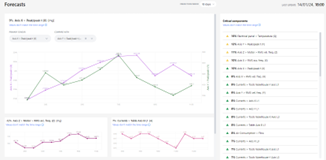Towards Process and Production Optimisation with XAI: The CNH Use Cases
CNH Industrial is a world-class equipment and services company, a global leader in the design and manufacturing of agricultural and construction machines, that employs more than 64.000 people in 66 manufacturing plants and 54 R&D centers in 180 countries. The collaboration with European partners of the XMANAI project was developed within the San Matteo plant, located in Modena, Italy. It is the most relevant R&D unit in the field of tractors in Europe, using the most advanced technologies for design and engineering purposes.
The Modena Plant faces production disruptions due to worn or faulty components, causing downtime and delays. CNH aims to optimize operations using XMANAI, leveraging XAI to swiftly identify and resolve issues, minimizing production losses. XMANAI analyzes data to provide actionable recommendations, improving decision-making and reducing costs, while ensuring operator trust and understanding.
Anomaly detection with AR support use case
The project is performing anomaly detection analysing real-time and historical data about the status of the CNC machine center to provide simplified suggestions to operators, optimizing production lines, and reducing costs.
A twofold benefit is verified:
1. Detect where the fault occurs, so that maintenance operators know which component is responsible and why, and can replace immediately the faulty part (for faster recovery);
2. Determine which anomaly caused the failure, so that the operators can track the occurred anomaly, reducing troubleshooting time and allowing them to focus on the actual cause, hence reducing recovery time.

The overall explainability design process resulted in the development of an interface for the manufacturing Web Application (App), shown in Figure 2. This App is specifically designed to provide transparent and interpretable explanations for the outputs and decision-making processes of AI systems. It includes features such as displaying active sensors, alarms, and trends of sensor data, and enables users to gain insights into the reasoning behind AI-generated outcomes. The App bridges the gap between the complexity of AI algorithms and the need for human understanding and trust. In detail, the ‘Sensor Values’ tab ranks sensors by criticality and allows to view trends over time, as well as provide feedback on the platform’s AI-generated suggestions. Additionally, an augmented reality application assists workers in maintenance procedures, with a focus on intuitiveness and explainability.

Forecasting use case
Forecasting with AI involves utilizing advanced algorithms and machine learning techniques to predict future trends, behaviours, or events based on historical data patterns. By analysing vast amounts of data, AI-powered forecasting models can adapt and learn from new data inputs, continuously improving their accuracy over time. Considering the end user would not blindly trust the results, all the potential of AI-based forecasting would be wasted without XAI.
With the introduction of forecasting in the XAI platform to optimize the production process, the maintenance operators will be helped to anticipate the downtime of the machine through the support of XAI suggestions that will be based on the values of the sensors installed and the historical downtime data. Maintenance operators will be ready in advance to tackle the anomaly and understand when, where, and why future faults may occur, to avoid micro-stops and prevent them.
A double benefit is achieved:
• Detecting when and where to order the piece in advance and replace the worn component before the faults occur
• Knowing why to allow production managers to take concrete actions to reduce the likelihood of errors occurring again.

Prediction of possible issues are integrated into the XAI Web Application, as shown in Figure 4. By adding the forecasting section in the App maintenance engineers have a clear view of the actual status of the machine and the potential failures. The history section of the App allows the operator to analyse the history of the most critical values for the machine failure and have insight on projection of critical values based on the historical trend. Displaying sensor values close to a dynamic threshold through a given time enables the user to order components or plan maintenance ahead of time, all using XAI.


The user is helped in understanding the relationship between sensor data and machine downtime. The trained algorithm provides scheduling suggestions to the production manager to improve the scheduling in the Plant Management System (PMS), and visualization tools are used to help operators understand the ΑΙ outcomes, promoting inspection and traceability of actions undertaken by the AI systems.
Results
The benefit that XMANAI brings to CNH is, in short, time-saving during the troubleshooting procedures. Approximately a time saving of 30 percent or more passing through the actual status to the first use case and another 10% passing through the first to the second. So XMANAI for CNH means a visible reduction of the time to reach the faulty part saving costs for the company.
Other benefits the company expects to gain from using XMANAI are as follows:
• Reduce emergency maintenance
• Reduce time/errors in machinery operations (maintenance/set-up/troubleshooting)
• Trust in XAI providing reduction of workload/stress of operators
The added value of XAI platform is the explainability associated with artificial intelligence. The evaluation of the platform through the questionnaire shows a positive impact of the XAI implemented in industrial environment. In fact, looking at the ratings recorded during the questionnaire, Figure 6, for the validation of the XAI Web-app, the explainability plays a key role.


